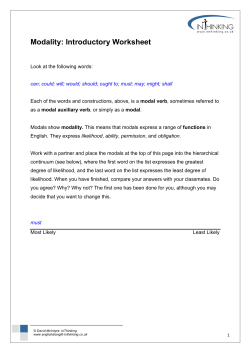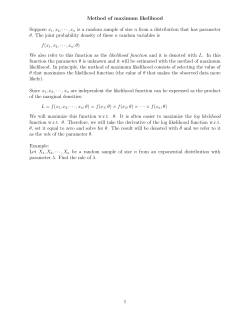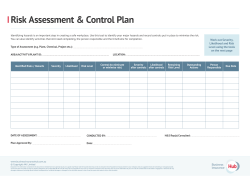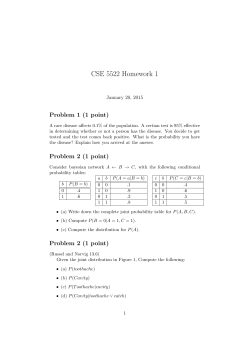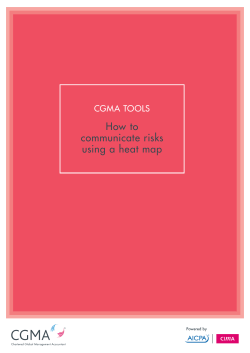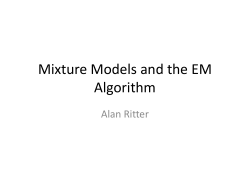
Homework 1 - Columbia University
COMS 4721: Machine Learning for Data Science
Columbia University, Spring 2015
Homework 1: Due February 10, 2015
Submit the written portion of your homework as a .pdf file through Courseworks (less than 5MB). In addition to your .pdf write-up, submit all code written by you in their original extensions through Courseworks. Please do not submit in .rar, .zip, .tar, .doc, or other file types.
Show all work for full credit. Late homeworks will not be accepted – i.e., homework submitted to
Courseworks after midnight on the due date.
Problem 1 (Maximum likelihood) – 25 points
Part 1. Imagine we have a sequence of N observations (x1 , . . . , xN ), where each xi ∈ {0, 1}. We model
this sequence as i.i.d. Bernoulli random variables, where p(xi = 1|π) = π and π is unknown.
(a) What is the joint likelihood of the data (x1 , . . . , xN )?
(b) Derive the maximum likelihood estimate π
ˆML for π.
(c) Explain why this maximum likelihood estimate makes intuitive sense.
Part 2. Now imagine another sequence of N observations (x1 , . . . , xN ), where each xi ∈ {0, 1, 2, . . . }.
We model this sequence as i.i.d. Poisson random variables with unknown parameter λ. The following
questions follow exactly from Part 1.
(a) What is the joint likelihood of the data (x1 , . . . , xN )?
ˆ ML for λ.
(b) Derive the maximum likelihood estimate λ
(c) Explain why this maximum likelihood estimate makes intuitive sense.
Problem 2 (Bayes rule) – 25 points
This problem builds on Part 2 of Problem 1. Again imagine we have a sequence of N non-negative
integer-valued observations (x1 , . . . , xN ), which we model as i.i.d. Poisson random variables with unknown parameter λ. We place a gamma prior distribution on λ, written λ ∼ Gam(λ|a, b), where
Gam(λ|a, b) =
ba a−1 −bλ
λ e .
Γ(a)
(a) Use Bayes rule to derive the posterior distribution of λ and identify the name of this distribution.
(b) What is the mean and variance of λ under this posterior? Discuss how this relates to your solution
to Part 2 of Problem 1.
Problem 3 (Linear regression) – 50 points
In this problem you will implement and analyze results using least squares linear regression. The goal
is to predict the miles per gallon a car will get using six quantities about that car. The data can be found
on the course website and on Courseworks.1 The data set contains 392 instances of different car models,
each containing a 6-dimensional feature vector (plus a dimension of 1’s for the intercept) contained in
X, and its average miles per gallon which we treat as the output contained in y.
Remember to include all original code with your homework .pdf submission.
Part 1. First, randomly split the data set into 20 testing examples and 372
Ptraining examples. Using the
training data only, solve a linear regression model of the form y ≈ w0 + 6j=1 xj wj using least squares.
(a) Print the numbers you obtain for the vector w
ˆML . Using the labels of each dimension contained in
the readme file, explain what the sign of each value in w
ˆML says about the relationship of the inputs
to the output.
(b) Use the least squares solution to predict the outputs for each of the 20 testing examples. Repeat
this process of randomly splitting into training and testing sets 1000
times. Each time, calculate
1 P20
the mean absolute error of the resulting predictions, MAE = 20 i=1 |yitest − yipred |. What is the
mean and standard deviation of the MAE for these 1000 tests?
Part 2. Using exactly the same training/testing setup as in Part 1, fit a pth order polynomial regression
model using least squares for p = 1, 2, 3, 4. (Note that p = 1 is equivalent to Part 1.) For each value of
p run 1000 experiments on randomly partitioned training/testing sets using 20 testing and 372 training
examples. For each experiment calculate the root mean squared error,
v
u
20
u1 X
t
RMSE =
(yitest − yipred )2 .
20
i=1
(a) In a table, print the mean and standard deviation of the RMSE as a function of p. Using these
numbers argue for which value of p is the best.
(b) For each value of p, collect y test − y pred for each test example. (Observe that this number can be
negative, and there are 20×1000 in total.) Plot a histogram of these errors for each p.
(c) For each p, use maximum likelihood to fit a univariate Gaussian to the 20,000 errors from Part
2(b). Describe how you calculated the maximum likelihood values for the mean and variance (this
is a univariate case of what we did in class, so no need to re-derive it). What is the log likelihood of
these empirical errors using the maximum likelihood values for the mean and variance? Show this
as a function of p and discuss how this agrees/disagrees with your conclusion in Part 2(a). What
assumptions are best satisfied by the optimal value of p using this approach?
1
See https://archive.ics.uci.edu/ml/datasets/Auto+MPG for more details on this
dataset. Since I have done some preprocessing, you must use the data provided on the course website.
© Copyright 2025
